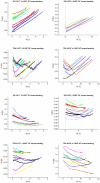Force-Controlled Biomechanical Simulation of Orthodontic Tooth Movement with Torque Archwires Using HOSEA (Hexapod for Orthodontic Simulation, Evaluation and Analysis)
- PMID: 37760157
- PMCID: PMC10525810
- DOI: 10.3390/bioengineering10091055
Force-Controlled Biomechanical Simulation of Orthodontic Tooth Movement with Torque Archwires Using HOSEA (Hexapod for Orthodontic Simulation, Evaluation and Analysis)
Abstract
This study aimed to investigate the dynamic behavior of different torque archwires for fixed orthodontic treatment using an automated, force-controlled biomechanical simulation system. A novel biomechanical simulation system (HOSEA) was used to simulate dynamic tooth movements and measure torque expression of four different archwire groups: 0.017″ x 0.025″ torque segmented archwires (TSA) with 30° torque bending, 0.018″ x 0.025″ TSA with 45° torque bending, 0.017″ x 0.025″ stainless steel (SS) archwires with 30° torque bending and 0.018″ x 0.025″ SS with 30° torque bending (n = 10/group) used with 0.022″ self-ligating brackets. The Kruskal-Wallis test was used for statistical analysis (p < 0.050). The 0.018″ x 0.025″ SS archwires produced the highest initial rotational torque moment (My) of -9.835 Nmm. The reduction in rotational moment per degree (My/Ry) was significantly lower for TSA compared to SS archwires (p < 0.001). TSA 0.018″ x 0.025″ was the only group in which all archwires induced a min. 10° rotation in the simulation. Collateral forces and moments, especially Fx, Fz and Mx, occurred during torque application. The measured forces and moments were within a suitable range for the application of palatal root torque to incisors for the 0.018″ x 0.025″ archwires. The 0.018″ x 0.025″ TSA reliably achieved at least 10° incisal rotation without reactivation.
Keywords: 3D measurement; biomechanics; force control; hexapod; orthodontics.
Conflict of interest statement
The authors declare no conflict of interest.
Figures



Similar articles
-
Biomechanical Simulation of Orthodontic En-Bloc Retraction Comparing Compound Technique and Sliding Mechanics Using a HOSEA Robotic Device.Bioengineering (Basel). 2024 Feb 2;11(2):153. doi: 10.3390/bioengineering11020153. Bioengineering (Basel). 2024. PMID: 38391639 Free PMC article.
-
Biomechanical simulation of forces and moments of initial orthodontic tooth movement in dependence on the used archwire system by ROSS (Robot Orthodontic Measurement & Simulation System).J Mech Behav Biomed Mater. 2023 Aug;144:105960. doi: 10.1016/j.jmbbm.2023.105960. Epub 2023 Jun 19. J Mech Behav Biomed Mater. 2023. PMID: 37348170
-
Torque efficiency of different archwires in 0.018- and 0.022-inch conventional brackets.Angle Orthod. 2014 Jan;84(1):149-54. doi: 10.2319/021713-138.1. Epub 2013 May 16. Angle Orthod. 2014. PMID: 23678999 Free PMC article.
-
Recent Advances in Orthodontic Archwires: A Review.Cureus. 2023 Oct 25;15(10):e47633. doi: 10.7759/cureus.47633. eCollection 2023 Oct. Cureus. 2023. PMID: 38022289 Free PMC article. Review.
-
Robotic Archwire Bending in Orthodontics: A Review of the Literature.Cureus. 2024 Mar 20;16(3):e56611. doi: 10.7759/cureus.56611. eCollection 2024 Mar. Cureus. 2024. PMID: 38646270 Free PMC article. Review.
Cited by
-
In vitro study examines posterior torque impact on 3D mechanics of anterior teeth in clear aligner treatment.BMC Oral Health. 2024 Apr 23;24(1):486. doi: 10.1186/s12903-024-04240-7. BMC Oral Health. 2024. PMID: 38654276 Free PMC article.
-
Investigation of Forces and Moments during Orthodontic Tooth Intrusion Using Robot Orthodontic Measurement and Simulation System (ROSS).Bioengineering (Basel). 2023 Nov 25;10(12):1356. doi: 10.3390/bioengineering10121356. Bioengineering (Basel). 2023. PMID: 38135947 Free PMC article.
-
Biomechanical Simulation of Orthodontic En-Bloc Retraction Comparing Compound Technique and Sliding Mechanics Using a HOSEA Robotic Device.Bioengineering (Basel). 2024 Feb 2;11(2):153. doi: 10.3390/bioengineering11020153. Bioengineering (Basel). 2024. PMID: 38391639 Free PMC article.
References
-
- Nakano T., Hotokezaka H., Hashimoto M., Sirisoontorn I., Arita K., Kurohama T., Darendeliler M.A., Yoshida N. Effects of different types of tooth movement and force magnitudes on the amount of tooth movement and root resorption in rats. Angle Orthod. 2014;84:1079–1085. doi: 10.2319/121913-929.1. - DOI - PMC - PubMed
LinkOut - more resources
Full Text Sources
Research Materials

